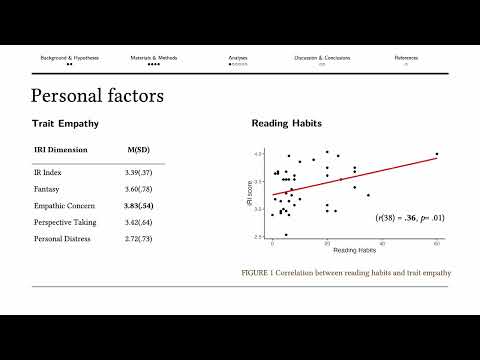 Speaker: Carmen Bonasera @CarmenBonasera
Speaker: Carmen Bonasera @CarmenBonasera
 Affiliation: University of Turin
Affiliation: University of Turin
Title: Can Emotional Atmospheres elicit Empathy? Measuring Reader Responses to Foregrounded Pathetic Fallacy and its Converse
Abstract: Foregrounding is a key term in the empirical study of literature, yet its conceptualization, measurement, and boundaries remain debated. In this symposium series, we present fresh approaches and perspectives from esteemed scholars and emerging researchers, sparking new discussions. The present symposium explores how foregrounding shapes literary atmosphere, empathy, and reader engagement. From analyzing empathic effects of pathetic fallacy to shared reading’s impact on processing and AI’s challenges with stylistic patterns, these presentations blend innovative methodologies with theoretical insights to deepen our understanding of this essential literary concept.

 Long abstract
Long abstract
The peculiar atmosphere of a literary text is often built through stylistic choices, particularly with the foregrounding of certain linguistic elements in favor of others, often through deviation or parallelism. A common strategy to create ambience is pathetic fallacy (henceforth PF), i.e., the literary technique of projecting emotions of an animated entity onto their surroundings, which, akin to foregrounding, works through imagery, repetitions and negations (Pager-McClymont 2022). Considering that PF is used to explicitly communicate emotions, exploring its role in shaping readerly emotions and empathy can shed further light on the link between textual features and readers’ responses (Hakemulder 2004). This paper builds on Pager-McClymont’s (2022; 2023) stylistic models of PF and of its converse—i.e., the occurrence of typical PF criteria but accompanied by an explicit contrast between the emotions expressed and the surroundings described—and aims at understanding: a) how PF and its converse contribute to the atmosphere of the text, and b) whether they affectively impact readers. To answer these questions, respondents recruited on a voluntary basis are first provided with relevant passages from two separate stories, one displaying PF, one showing its converse. Perceived foregrounding is measured through a two-step assessment following the protocol developed in Scapin et al. (2023), by asking participants to highlight parts of the text that they find as deviating from normal discourse and analyzing their processing and aesthetic appreciation, whereas affective and empathic reactions are measured quantitatively. The hypothesis is that, among individuals that succeed in processing foregrounded features, PF is associated with higher empathic reactions than its converse, since the latter’s highly defamiliarizing opposition between surroundings and emotions may hinder the potential for readerly empathy.
References
Hakemulder, F. (2004). Foregrounding and its effect on readers’ perception. Discourse Processes 38(2), 193–218.
Pager-McClymont, K. (2022). Linking emotions to surroundings: a stylistic model of pathetic fallacy. Language and Literature 31(3), 428–454.
Pager-McClymont, K. (2023). A stylistic model of the converse of pathetic fallacy. Language and Literature 33(1), 44–68.
Scapin, G., Loi, C., Hakemulder, F., Bálint, K., & Konijn, E. (2023). The role of processing foregrounding in empathic reactions in literary reading. Discourse Processes 60(4-5), 273–293.

